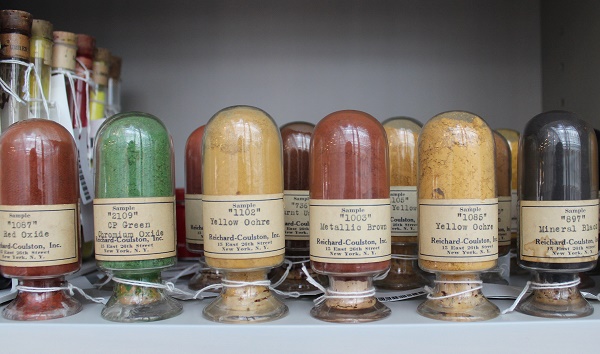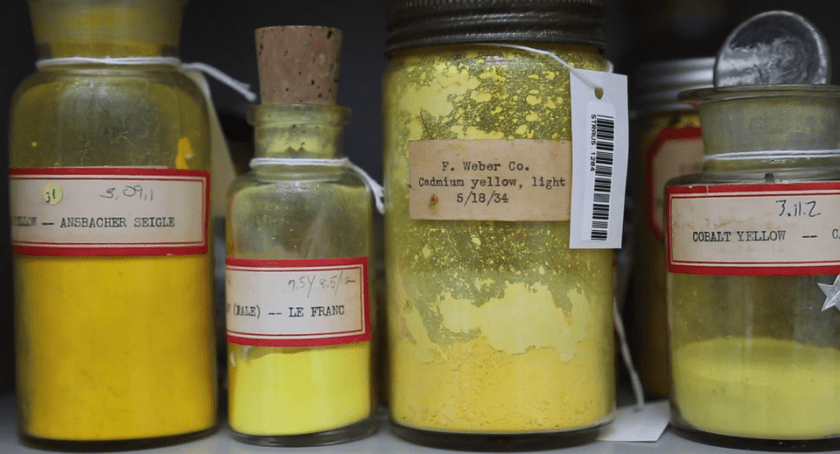Like most artists, I’m addicted to art supplies. Let me loose in an art shop, and I can spend hours amongst the multitude of paints on offer, trying hard not to bankrupt myself.
Nowadays paint is mostly made in labs, using different chemical substances, but artists in the past made their own supplies, using whatever materials they could find—including ‘the impossibly esoteric, the dangerously toxic, the prohibitively expensive, and the perilously fugitive,’ according to writer Simon Schama (article in the New Yorker, September 3, 2018). It’s a process I find extremely interesting, although I’m quite happy to squeeze ready-made paint out of a tube myself.

Imagine then my delight when I came upon an article on the Forbes Pigment Collection, a technicolor array of more than 2,500 samples, housed at the Harvard Arts Museums. The collection was started by Edward Waldo Forbes in the early 1920s, after he purchased a damaged Renaissance painting of the Virgin and child. Hoping to restore the painting to its original brilliance, Forbes realized that he needed to understand the materials he was working with. Forbes was the director of Harvard’s Fogg Museum from 1909 to 1944, and he firmly believed in the interdependence of art and science.

Arranged according to the exploded color wheel, the thousands of shades on display in the Collection — some poisonous, others impossibly rare — are a library of more than just color. Scientists and art historians tap into the collection in order to verify the origins of questionable paintings up for auction, or work to identify the key compounds of ancient colors in order to better preserve cultural masterpieces for generations to come.
The stories behind the pigments are endless, but some particularly stand out. Here are some of the best:
Dragon Blood: The legendary pigment was purportedly gathered from dragon wounds in the Middle Ages; more accurately, its color comes from tree resin. Conservation scientists at the Collection are working to unlock the mystery of this centuries-old pigment.
Mummy Brown: Made from the ground up remains of actual Egyptian mummies, mixed with white pitch and myrrh, it was used from the sixteenth century until late in the nineteenth when supplies ran out. At the time the mummies were imported into Europe in large numbers to be used for medicinal purposes (Ugh…)

Tyrian Purple: An ancient Phoenician dye that requires 10,000 mollusks to produce a single gram of pigment, is said to have been discovered by Hercules’s dog as he snuffled along the beach. It is a secretion produced by several species of predatory sea snails in the family Muricidae, rock snails originally known by the name Murex. Being extremely expensive to produce, it became very popular during the Byzantine Empire (Ancient Greek: πορφύρα, porphúra,) where its production was tightly controlled and its use restricted to the dyeing of imperial silks. Thus a child born to a reigning emperor was said to be porphyrogenitos, “born in the purple”.

In the reds range, Crimson is produced from the dried bodies of the kermes insect, which were gathered commercially in Mediterranean countries, where they live on the kermes oak, and sold throughout Europe; while Carmine is made from the dried bodies of the female cochineal, and was probably brought to Europe during the conquest of Mexico by the Spaniard Hernán Cortés.
Indian Yellow: It was noted for its intense luminance, was widely used in cloth dyeing and was especially well known from its use in Rajput-Mughal miniature paintings from the 16th to the 19th century. Indian yellow pigment was originally manufactured in rural India from the urine of cattle fed only on mango leaves and water. The urine would be collected and dried, producing foul-smelling hard dirty yellow balls of the raw pigment, called “purree”. The process was allegedly declared inhumane and outlawed in 1908, as the cows were extremely undernourished, partly because the leaves contain the toxin urushiol which is also found in poison ivy.

Lapis Lazuli is a deep blue metamorphic rock used as a semi-precious stone that has been prized since antiquity for its intense color. As early as the 7th millennium BCE, lapis lazuli was mined in northeast Afghanistan. At the end of the Middle Ages, it began to be exported to Europe, where it was ground into powder and made into ultramarine, the finest and most expensive of all blue pigments. Its rarity and brilliant hue, as well as the difficulty and expense of the extraction process made it more expensive than gold. It was used by some of the most important artists of the Renaissance and Baroque, including Masaccio, Perugino, Titian and Vermeer, and was often reserved for the clothing of the central figures of their paintings, especially the Virgin Mary.
Artists often took risks to create their works, using poisonous pigments like Emerald Green (a toxic copper-acetoarsenite) to get the color just right; or White Lead, a pure white pigment obtained by corroding metallic lead with acetic acid in the presence of carbon dioxide. This was done in pots with a little vinegar added, which were stacked up and covered with a mixture of decaying dung and spent tanner’s bark.

The Forbes Collection is constantly updated as many artists donate new samples. It could be described as a conservator’s crystal ball: offering glimpses into the aging process for various pigments, binders, and any other materials that might make their way into a work of art. Experts also might use the collection to evaluate the legitimacy of a painting’s attribution to an artist. By analyzing the chemical makeup of the pigments used in a painting and comparing them to the known standards of the Forbes collection, analysts can determine whether the colors used would have been available to a specific artist during their lifetime, or if a pigment would be available in the region from which the painting is believed to have originated.
One example is the verification of a painting by Jackson Pollock that went on the market a few years ago. Curators were ready to assert the painting was genuine, until this lab ran tests of the pigments that were used, using pigments in the collection as a standard, and discovered that the red that was used was not available in art-making materials until 20 years after Jackson Pollock had died.

Among the collection’s newest acquisitions are samples of Vantablack, a material developed by Surrey NanoSystems in the United Kingdom which is one of the darkest substances known, absorbing up to 99.96% of visible light. It was intended for military purposes and astronomy equipment, but there is an amusing story attached to it, because the company exclusively licensed it to artist Anish Kapoor’s studio for artistic use. This caused outrage among some other artists, including Stuart Semple. In retaliation, Semple banned Kapoor from buying Pinkest Pink, a strongest shade of pink that he had developed. However, in 2016 Kapoor got his hands on some Pinkest Pink and posted an Instagram post of his middle finger dipped in it. Semple then created another shade of paint made from crushed glass as a retort to Kapoor, and later barred Kapoor from buying other products of his, including his extremely strong shades of green and yellow paint as well as a paint sold as Black 2.0, which is nearly indistinguishable to Vantablack VBx, despite being acrylic. If one wanted to buy any of these paints, they would have to sign a contract stating that they were not Anish Kapoor and didn’t intend to give the paint to Kapoor. Vanity? Performance art? You choose.

All photos Google


Wonderfully colourful blog!!
Remind me to wear more purple.
LikeLike
Thanks! Yes, we’re probably allowed, due to our illustrious ancestors… But now it’s all chemically produced, so less exclusive😊
LikeLike
Fascinating !!!!
LikeLiked by 1 person
A really fun read! I’ve always wondered how some of these colour remain stable so long, considering they’re made from organic substances; the minerals seem more logical, but even those could be a bit fugitive, especially the oxides. And now you’ve created a longing for some Vantablack, the mattest of matt blacks…
LikeLiked by 1 person
You can’t have any, only Anish Kapoor is allowed🤣🤣
LikeLike
You always find fascinating stuff to blog about!
LikeLiked by 3 people
Thanks, Bruce! If it’s not fascinating (to me, at least,) it’s too much like homework!
LikeLiked by 1 person
Fascinating stuff. Have you come across a book called The Secret Lives of Colour by Kassia St Clair? If not, it might be of interest to you.
https://guardianbookshop.com/secret-lives-of-colour-607491.html
LikeLiked by 1 person
Thanks, Jacqui. I’ll look it up!
LikeLike
That’s so interesting. I knew paint colours have a history, but I didn’t realise it was so exciting and dangerous.
LikeLiked by 2 people
And difficult. It’s hard enough getting an color you need by mixing others, but if you have to start grinding up stones and mixing in egg yolks…
LikeLiked by 2 people
It must have been frustrating to know the colour you wanted and to know the recipe, but not be able to get the ingredients.
LikeLike
Yes, that too…
LikeLiked by 1 person
I think they went to great lengths to do so
LikeLiked by 1 person
There’re some great stories there. Have you read ‘Colour’ by Victoria Finlay? It’s a big book full of those sort of stories.
LikeLiked by 2 people
No, but I’ll look it up. Thanks!
LikeLiked by 1 person
Fascinating. I can see why
LikeLiked by 2 people
Wow, these are some gorgeous colours. The story behind mummy brown was pretty interesting, too. I never would have thought to grind up a mummy for that purpose.
LikeLiked by 2 people
Sounds disgusting 😬
LikeLike
Fascinating! I love some of the color names.
LikeLiked by 2 people
Thanks!
LikeLike
The history of paint is indeed fascinating. Many of the most famous artists were almost bankrupted by the cost of specialist paints. Great post, Marina.
Best wishes, Pete.
LikeLiked by 2 people
Thank you, Pete. Fascinating indeed
LikeLiked by 1 person
Wonderful colors, and history. I love those old jars too.
Wow, just wow! I wonder how long the Semple/Kapoor feud will last?
LikeLiked by 1 person
You are an art historian, Marina. This is such a fun and fascinating article – history, science, art, detective sleuthing, myth, fantasy, even a bit of a Hatfield-McCoy feud thrown. I can see a novel germinating somewhere. Have you read “The Last Painting of Sara De Vos” by Dominic? It’s a wonderful book, but I’ll spoil it to say too much except that the premise is based on an undetected pigment in a very old painting. I’m surprised you didn’t mention verdigris, a greenish color meaning “green of Greece.” It was a very fugitive green shade that changed over years, so what we see of it in paintings today is likely very different from artists’ original intentions. This was so much fun that I’ve read it twice.
LikeLiked by 1 person
Sometimes art supplies can almost be an artwork in themselves!
LikeLiked by 1 person
Yes, aren’t they! I’m addicted 😊
LikeLiked by 1 person
Last week I got some mermaid themed paint brushes and now I need to get the unicorn ones lol.
LikeLiked by 1 person
It never ends, does it?😬
LikeLiked by 1 person
Fascinating post, Marina. I had no idea that there was so much competition in the art world over the blackest or the pinkest etc.. 😅
LikeLiked by 1 person
Hilarious, isn’t it?
LikeLiked by 1 person